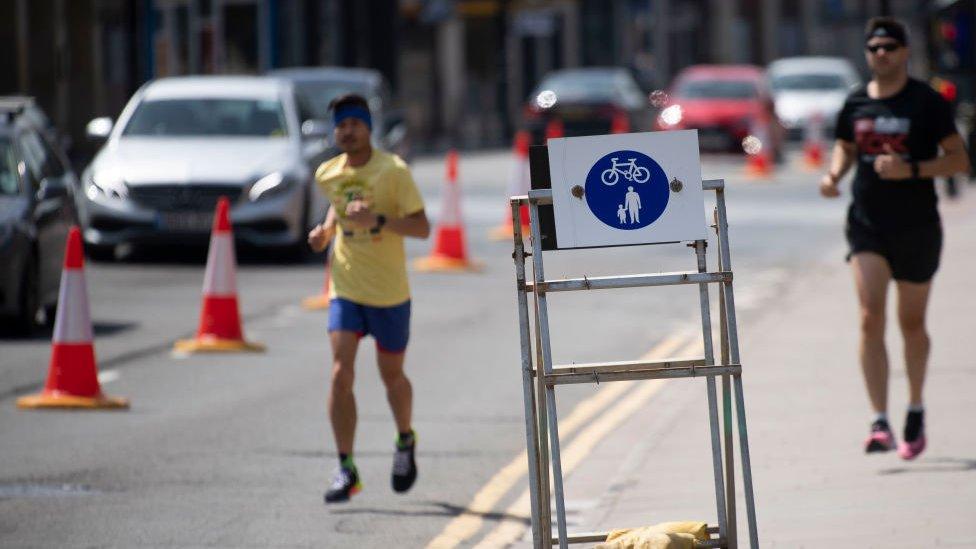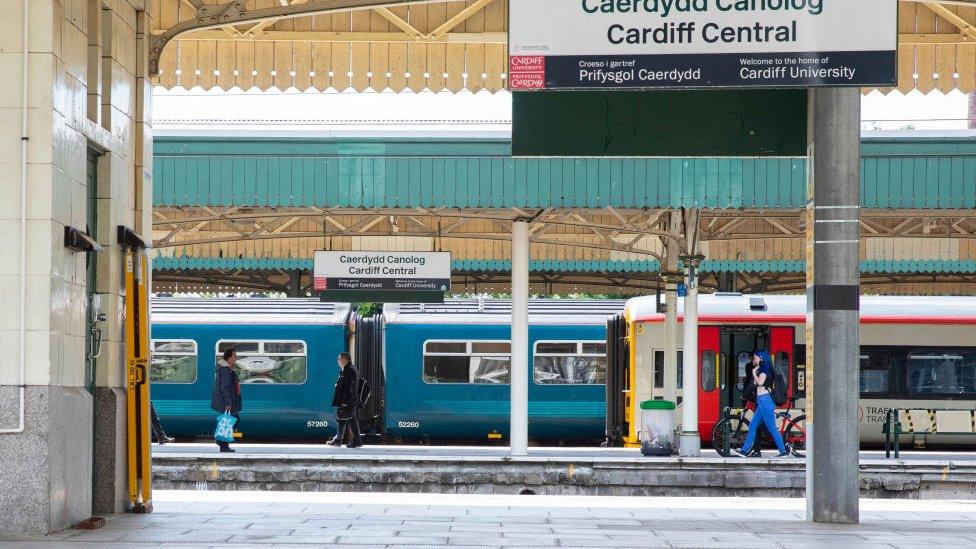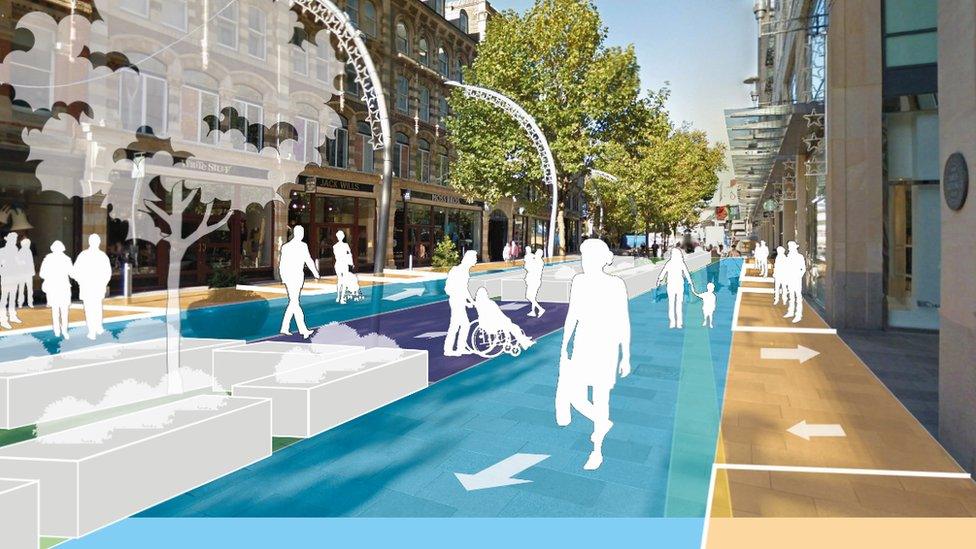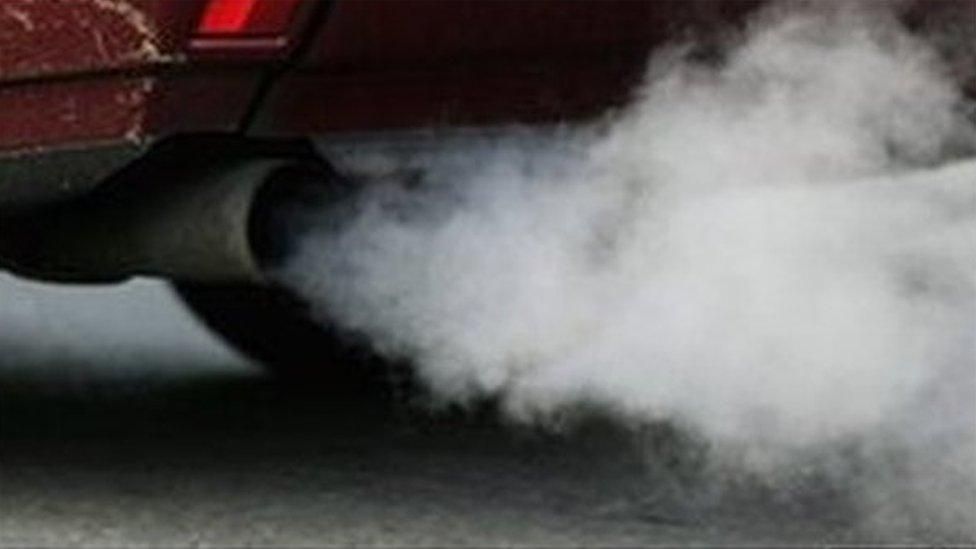Coronavirus: Rise in Cardiff traffic 'detrimental' for environment
- Published
Could congestion charges help solve Cardiff's pollution?
People switching back to driving due to problems using public transport could have a "detrimental impact" on pollution in Cardiff, a report warns.
Before lockdown the air quality averages in the capital were among the worst in the UK.
But a report shows, external overall air quality in Cardiff "has significantly improved" during the pandemic.
The council now hopes to introduce a network of "pop-up" cycle paths in its plans to "reopen the city".
In January, the council had announced proposals to bring in a £2 congestion charge for non-residents entering the city by 2024, in a bid to reduce congestion and pollution.
But during lockdown, with more of people working from home and shops and activities closed, traffic in the city centre fell dramatically, and numbers using public transport plummeted.
In Cardiff's Recovery Strategy, to go before the council's cabinet on Thursday, the council's director of economic development Neil Hanratty said social distancing was a "crisis for public transport".
He said urgent action was needed to prevent a "large-scale increase in car trips which would be detrimental to both the economic and environmental resilience of the city".

What has the impact been on pollution?

Members from two different households are now able to exercise together under the rules in Wales
Before lockdown Cardiff was judged to have the fourth worst air quality in the UK, according to Birmingham University.
But the council report states that levels of nitrogen dioxide (NO2) have dropped significantly since 16 March.
"Many areas have seen an improvement in air quality and reduction in traffic noise due to the lower levels of car traffic, and local communities are keen to retain this," said Mr Hanratty.
Nitrogen dioxide levels in the city centre have more than halved, with a daily average reading of 9.5µg/m3 (micrograms per cubic metre) measured at Cardiff's city centre monitoring station.
This is compared to a daily average of 21.5μg/m3 this time last year, although the figures cannot be directly compared due to different factors which can influence air quality.

How has the lockdown changed how we travel?

Rail journeys have fallen by 95% in Cardiff since the start of lockdown
At the start of lockdown people were only allowed to travel for "essential journeys" in Wales, including to go to the shop once a day, and if you could not work from home.
On 1 June rules were eased, to allow for travel to exercise, or to see loved ones from one other household at a time but only within five miles of your home.
According to the Cardiff council report:
During early stages of lockdown the number of cars on roads fell by about a third
But by the end of May traffic levels were on the rise, up to about half of that on the road pre-pandemic
Trains have seen a 95% drop in passengers during the pandemic
While there has been a 90% reduction in people using buses
Footfall in the city centre has fallen by 90% during lockdown
But walking and cycling numbers have shot up by more than 50% compared to pre-lockdown figures, which the report suggests shows people are taking their "daily exercise".


Climate protestors previously held a demonstration on Castle Street - highlighted as a pollution hot spot
The report warns that social distancing measures could be "catastrophic" for public transport and for the environment unless urgent action is made.
Under the two-metre rule, it is estimated that only 15% of seats on buses and trains will be useable, leading to less income for companies, and people having to find alternative ways of travel.
Cardiff council has put together plans to "reopen the city centre", with a one-way system and over-spill areas to try and help bars struggling with social-distancing measures.
There are plans to widen footpaths and to build a "network of pop up cycle ways" linking existing and new cycle paths to the city from towns and villages and popular beauty spots.

The Hayes is one of the areas which will be redesigned under plans to "re-open" Cardiff
Mr Hanratty said the recovery period was an opportunity for the council to "secure increased environmental and city resilience".
He said that improving air quality could help improve public health, and "reduce the impact of the coronavirus pandemic" and "help increase resistance to any future waves of virus".
He added: "An increase in car-based trips would have an adverse impact on air quality, as well as emissions of greenhouse gases.
"It is necessary to prevent a potential modal shift to car-based journeys, as people switch from public transport and other sustainable modes to avoid busy environments, through supporting active and sustainable modes of travel."
- Published5 June 2020

- Published8 January 2020
